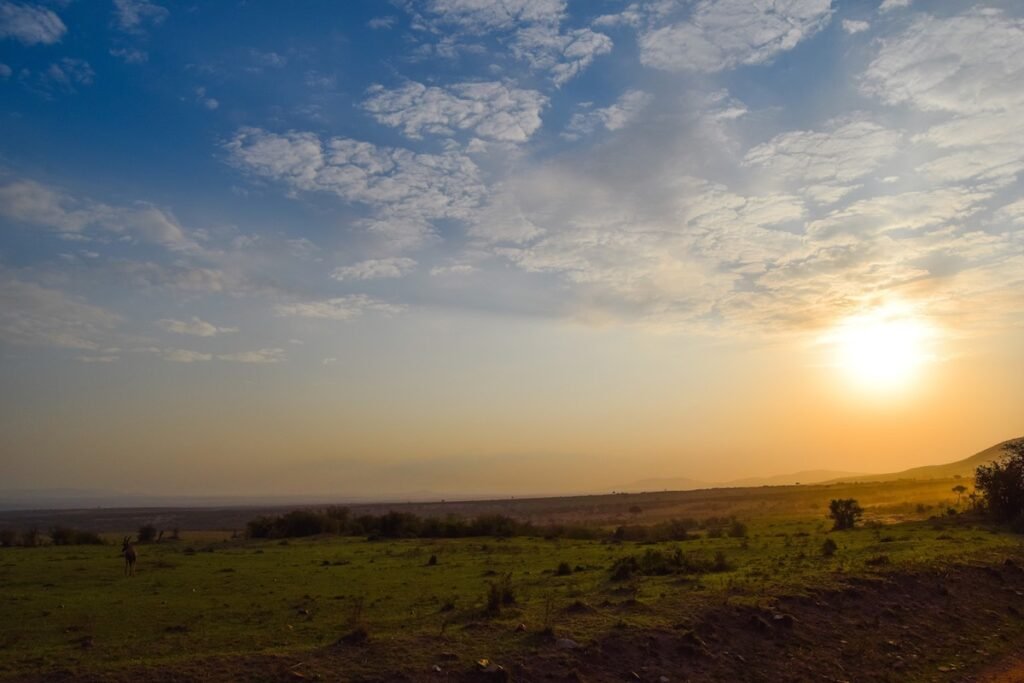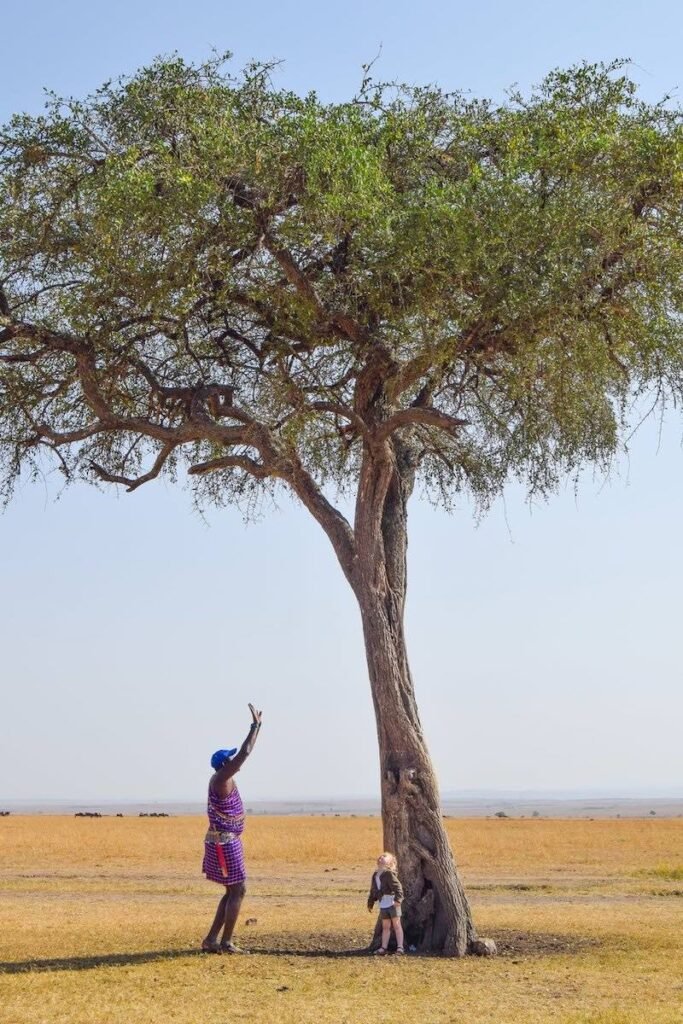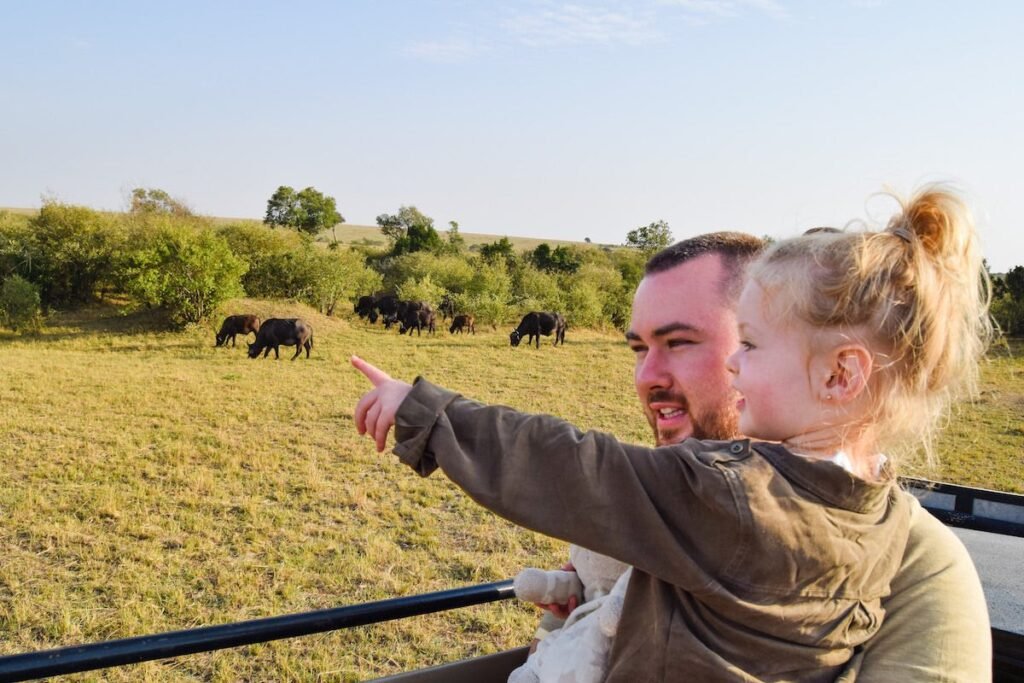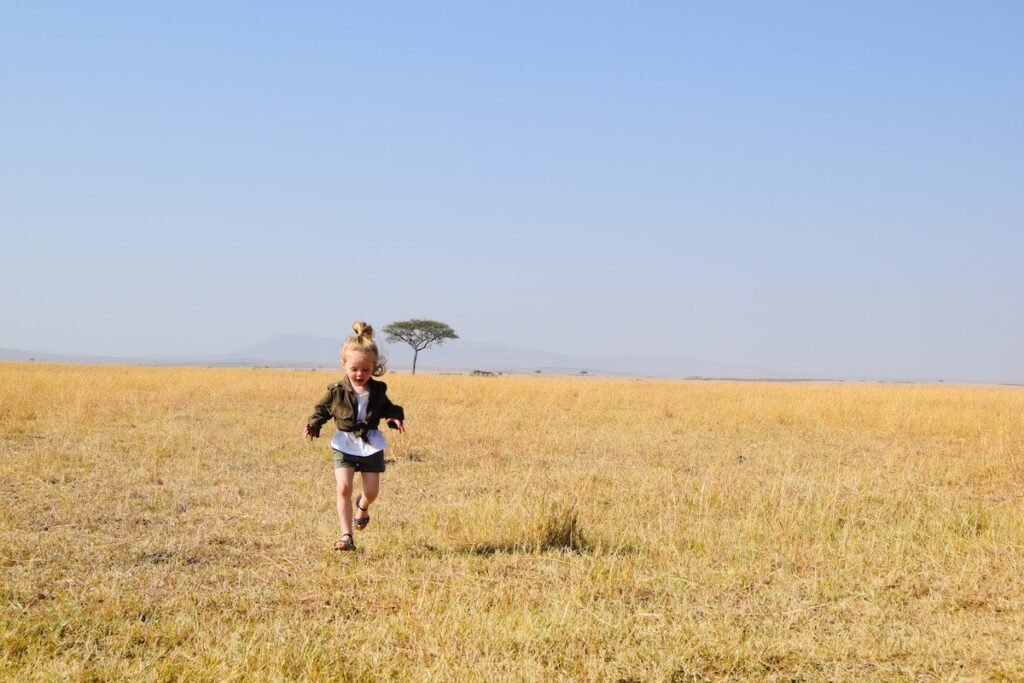African Safari With Kids – Here’s How
We booked our safari through Maji Moto Maasai Cultural Camp and it was absolutely incredible from start to finish. To enquire further about booking your own safari through them, click here.
Can you take children on safari?
If you are eager to go on a safari to see the big 5 but think a safari with children is off the cards, you’ll be pleased to know it’s an experience that doesn’t have to be put on hold until they are older, or have flown the nest, but can be embraced in all its glory while they are young! It’s 100% doable, having done a Kenyan family safari ourselves, standing as one of the most exhilarating, memorable travel experiences we’ve had to date. With some careful planning, taking your little ones into consideration, and the National park you choose to visit, you can definitely tick this off your bucket list.
Best countries for safari in Africa
From doing ample research prior to choosing which country to safari in, we learned that the most popular options were Kenya, Tanzania, South Africa, Namibia, Botswana, Zambia, and Zimbabwe. All of these offer superb opportunities to see animals in their natural habitat, however, some countries appealed to us more than others as first-time safari goers.

Why did we choose to safari in Kenya?
Due to travelling with a 2-year-old at the time, we wanted to have a small taster of going on safari, in order to see if we actually liked it, as opposed to embarking on a long safari trip lasting numerous days. We thought we’d test the water, aiming to find a country where we could sample a one-day safari, along with delving into other experiences within the country. Due to wanting some beach time, this automatically ruled out Botswana, Zambia, and Zimbabwe, as they are landlocked countries with no coast.
We had long dreamt of staying with a Maasai tribe, making Kenya and Tanzania very appealing, along with the fact that during August (when we were due to visit) it coincided with the world-renowned great migration, where millions of wildebeest move from the Serengeti in Tanzania into the Masai Mara, Kenya. The east coast beaches of both these countries looked idyllic, so we were excited at the prospect of adding those into the mix.

The deciding factor for us in choosing Kenya was internal travel distances within both of these countries. Although there were convenient internal flights from both countries’ capitals to their national parks, we soon realised this would ramp up our trip cost, so set ourselves the target to travel by land as much as possible. The travel distance from Tanzanias capital of Dodoma to the Serengeti by car was over 10 hours, whereas to get from Kenya’s capital Nairobi, to the Masai Mara, it was only 5 hours. The latter, seemed a much more reasonable distance to travel with a 2-year-old, so Kenya had the upper hand.
Little did we know at this stage, we would actually end up staying with a Maasai tribe in Kenya, in a place called Maji Moto, which was only 3 hours from Nairobi by bus and 1.5 hours from the Masai Mara. This broke up the travel distances into more reasonable chunks. So Kenya it was, it had everything we wanted in one country – safari, Maasai tribes, beautiful beaches, and reasonable travel distances.
Best time to go on safari
If you love hot weather and are willing to miss the great migration in order to feel the heat whilst on safari, then between December and March is Kenya’s hot dry season, where daytime temperatures can reach as high as 31°C and the air becomes increasingly humid. Due to us travelling in Kenya with kids, it appealed to us much more to visit in the cool dry season, running from June to October, when average daytime temperatures are 23ºC during the day, with highs of 27ºC on the coast. We did need to take a jacket for the evenings, however, in the day, we happily wore shorts and a T-shirt.
The dry seasons, are the best time to go on safari, because the lack of rain results in the vegetation across the Masai Mara reducing and allows visitors the chance to spot wildlife much more easily. Animals must source water more specifically from the reduced water holes, so game drives often see many animals congregating around them together to drink, it’s honestly like something out of The Lion King! Daytime temperatures during the cool season allow wildlife sightings throughout the day, as animals have less need to seek shade with no strong midday heat which is present during the hot season.
Granted, August is Kenya’s peak tourism season, however, we saw this trip as a once-in-a-lifetime opportunity and wanted to make sure our chances of a successful safari were as high as possible. We booked well in advance so had a good range of accommodations to choose from and our safari guide was absolutely incredible, taking us off the beaten path, within the Masai Mara to see the animals, without the hordes of other tourists being present – more on that to come.
Malaria is a risk throughout the country at all times of year, and you should definitely visit Fit For Travel to get advice on taking antimalarials, there are however more mosquitos in the wet seasons running from March to June and then again from October to December. Maybe we had luck on our side, however, we only saw 1 mosquito throughout our entire 3 weeks in Kenya and none of us got bitten at all.
Is it safe to take children on safari?
When we told relatives and friends we were taking our two-year-old on safari to Kenya, they looked at us like we’d lost the plot. “Why don’t you wait until she’s old enough to remember it?” was the common response, or “Aren’t you scared she’ll get eaten by a lion?” We weren’t irresponsible in our eyes, just a little more adventurous with our destinations and activity choices, compared to those who prefer to stay in their comfort zone when going on holiday. We figured after doing tons of research, that taking young children on safari had been done before, it will be done again, so why not by us?
We were adamant about finding a highly reputable company to complete the safari with because although we were aware we could undertake a self-drive safari, let’s face facts, we were no safari experts, and for our first taste of safari, we wanted it to be seamless and stress-free. We didn’t feel confident navigating our way around the Mara to find the animals and wanted to experience our first safari in the safe hands of an expert.
If you have the support of a knowledgeable guide, as we did, they will get you to the Masai Mara, navigating the roads leading up to the national park, which are extremely bumpy, or they will depart from your safari lodge, already situated within the reserve. You will be kept safe within a safari jeep, and if you’re permitted to get out of your vehicle like we were, your guide will instruct you when it is safe to do so. Your guide will know the likely spots to find the animals and provide valuable information, along with how you must behave whilst in close proximity to them.

Antimalarials for a safari in Kenya
It’s most important to seek professional medical advice before going on safari in Kenya. Medical guidelines change over time and you must make sure you are up to date with the most recent ones. Visit Fit For Travel to find out more information.
At the time of visiting Kenya, antimalarials were advised by our local medical practice for travel, so after a thorough consultation, we were advised on the appropriate antimalarials for us all to take, including ones most suitable for our two-year-old daughter. We were informed that ‘Atovaquone & Proguanil’ also called ‘Malarone’ although the most expensive type, were least likely to give us any ill side effects and were most recommended for children to take.
We gave Carmen her tablets, crushed up on a spoon, and covered in jam and she had no problems taking them thankfully. We can only speak from personal experience, but none of us had any ill side effects at all, no upset stomachs, no sunburn or sensitive skin, which we’d been told other antimalarials sometimes gave.
Where to stay in Kenya for safaris
Many safari companies will offer lodge/ tent style accommodations within the Masai Mara park itself, which we did initially look into, as it would have been beneficial staying in situ. Some were well out of our budget, or more importantly didn’t accept children under 6, which ruled us out. This turned out to actually be a blessing in disguise as we soon discovered Maji Moto Maasai Cultural Camp through a recommendation from a friend and once we’d found out what they offered we didn’t look back!

This extraordinary place, located on 200 private acres of savannah, at the foot of the Loita Hills was only 45 minute drive from the Masai Mara National Park and the beauty of staying here was we were able to stay alongside an authentic Maasai tribe. This was a dream come true, not only did it allow us to fulfil two major bucket list dreams, going on safari (which they facilitated for us) and experiencing Maasai culture, but they were so incredibly child-friendly. From the initial emails enquiring about staying, right through to our stay itself, Maji Moto Maasai Cultural Camp went above and beyond and provided for our family, what can only be described as a life-changing experience, it was phenomenal. Read more about our stay with them here.
What to expect when you go on safari
Every safari provider will offer a slightly different package, with the initial deciding factor being whether you’d like to do a group safari or a private safari. Although these group bookings are cheaper, you will be on a large safari bus with other tourists, and for us, the thought of trying to keep a two-year-old under control on a group tour, filled us with dread! We knew we needed a private safari to cater to our family’s needs, tailoring in toilet breaks, snack breaks, and nap time whilst keeping any possible toddler meltdowns tucked safely inside our private jeep, so we didn’t disturb any budding safari enthusiasts.

We feel that the one-day safari offered by Maji Moto Maasai Cultural Camp was absolute perfection. They provided a knowledgeable local Maasai driver called Tira, who picked us up at 5 am from the camp in a safari jeep and drove us 45 minutes to get to the entrance gates of the Masai Mara. The bumpy roads rocked Carmen to sleep in minutes accompanied by the large amount of blankets the camp had allowed us to take with us, turning the back row of seats into the comfiest bed for her.
On arrival at the Mara, we gave Tira our passports and he kindly sorted out our entrance to the park, while we stayed in the jeep, stress-free. After this the fun really began, spending the next 7 hours exploring the park with our knowledgeable driver.

We know what you’re probably thinking, ‘how could you spend that long in a car with a two-year-old? You must be mad!’ In all honesty, we weren’t stuck in the jeep for that long but were actually allowed out on plenty of occasions. Our ‘pop top’ safari jeep also came with the option to open two large roof windows which allowed us to stand up, (Carmen standing on the seat) and look out of the roof, for superb views.
The jeep had a capacity for 7 people, the driver, and 6 passengers, with 2 seats in the front, 2 in the middle, and 3 in the back, meaning we all had lots of room and Carmen was able to fidget around the space, as toddlers do, without impacting our comfort.
Tira knew exactly where to find the animals and took us to many different areas of the park, away from the hordes of other safari jeeps. We initially saw a family of giraffes, then two ostriches putting on a flamboyant mating performance, followed by zebras, wart hogs, and hyenas. Carmen listened carefully to Tiras instructions to stay nice and quiet as he explained enthusiastically to her what all of the animals were and their key characteristics.

He then recommended we stop for breakfast and pulled up underneath a lone Acacia tree, in the middle of the savannah. He laid on the ground a beautiful red Maasai shuka and covered it with food prepared by Maji Moto Maasai Cultural Camp. We had fresh fruit, eggs, bread, yogurts, fruit juice, and a nice flask of hot tea, it was superb. We relaxed, and took in the scenery, Carmen had a run round, all under the close watchful eye of Tira, who repeatedly reassured us all was well.
It was at this point a herd of wildebeest ran past us which was incredible to see and was without a doubt one of the most memorable travel experiences we’ve had to date. It matched up perfectly with the pictures we’d seen online of the vibrant Kenyan plains, we felt like we were dreaming!


Back in the jeep, Tira tracked down a whole pride of lions, and a coalition of cheetahs, and when I say we got up close, we were literally a few meters away. We then went to see the great Mara river where the wildebeest cross and had the pleasure of seeing hippos wallowing in the mud. Before we knew it, it was lunchtime, where Tira once again laid out another spread of food under the shade of the trees and we all tucked into crisps, fruit, and sandwiches together. Carmen had missed her afternoon nap by this point, but the day had been so exciting I don’t blame her for not wanting a sleep.
After lunch, we were taken on an exhilarating ride along a really bumpy area of the Mara, which had us all bouncing around in the back of the jeep in hysterics, before stopping to see a herd of elephants. This was such a phenomenal sight, especially when compared to seeing how poorly we’ve seen elephants treated for tourism purposes in other countries we’ve visited, it simply moved me to tears!


So split between hunting for the animals in our jeep, observing them, having the most incredible breakfast break, lunch break, snack breaks both inside and outside of the vehicle, and a handful of travel potty breaks, our 7-hour safari had somehow come to an end. We left the park at dusk and were driven 45 minutes back to Maji Moto Maasai Cultural Camp for our third night with the Maasai tribe.

What to pack for a safari
- Appropriate clothing – Take some warmer layers with you as the early mornings are often cool
- Solid pair of closed-toe shoes
- Mosquito spray
- Suncream/sunglasses & a hat
- Hand sanitiser
- First aid kit
- Plenty of water
- Lots of snacks
- Baby wipes – You will get really dusty, so these are great for wiping off the dirt
- Binoculars – Pack at least one pair, more if there are more children
- Camera/phone
- Portable charger
- Travel potty
- Wildlife books / Some are geared toward children.
- Head torch
What to wear on safari
You’ll need as previously mentioned, a few layers, which you can have the option to wear in the early morning, when it’s often much cooler and then you’ll be able to then take some off as the sun rises and it gets warmer. Aim for neutral colours, to allow you to blend into the bush and help to stay hidden from any animals you’re watching. We chose the classic khaki green safari colours.
To enquire about booking your own family-friendly safari with Maji Moto Maasai Cultural Camp, click here.
Do you have any questions about taking kids on safari?
We appreciate that it can be quite overwhelming trying to organise a safari with little ones. Feel free to leave a comment below with any additional questions you may have and we’ll do our best to answer them for you.






